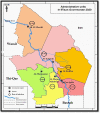Control study of Musca domestica (Diptera, Muscidae) in Misan Province
- PMID: 38106654
- PMCID: PMC10721963
- DOI: 10.12688/f1000research.132636.2
Control study of Musca domestica (Diptera, Muscidae) in Misan Province
Abstract
Background: Houseflies are the most common type of Diptera, specifically Muscidae, worldwide, representing more than 90% of all species. This family has over 170 genera and 4200 species, but a few are of medical significance. This study aimed to estimate and assessing the measures to control and prevent grow-up inside houses and flying of the housefly ( Musca domestica Linnaeus, 1758) in Misan.
Methods: The study occurred over 12 months, from December 2020 to December 2021. Using plastic containers, Musca domestica were collected from all potential breeding sites in the study region (inside and around houses). Sticky oil paper and traps were used to collect the insects. The collected insects were transferred to sealed plastic containers and then to the laboratory of the Department of Microbiology.Out of 200 randomly selected houses, 150 (75%) contained insects. Light traps and sticky oil papers were the most effective control measures, with 26.7% and 25.9% of the Musca domestica collected from these methods, respectively. The ratio of male (233) to female (456) Musca was 1:2, with a significant difference between the frequencies (P<0.05). A large population of houseflies was collected during the hot season (501, 72.7%), whereas fewer Musca were collected during the cold months (188, 27.3%), with a strongly significant difference (P<0.05). The percentage of HI was 54.4%, the CI was 21.9%, and the BI was 79.9%. The overall larval densities (LD) were at a medium level.
Conclusions: Misan has a high density of Musca domestica, with females being more prominent than males. Hot climate, humid sites, and dirty places are responsible for the breeding of houseflies. The overall larval density was medium. Therefore, the risk of transmitting infectious diseases by houseflies is high within the boundaries of Misan province, and effective control parameters should include measures like light traps and sticky oil.
Keywords: Container Index; House Index; Housefly; Musca domestica; larvae.
Copyright: © 2023 Alsaad R.
Conflict of interest statement
No competing interests were disclosed.
Figures
References
-
- Nmorsi OP, Ukwandu NC, Agbozele GE: Detection of some gastrointestinal parasites from four synanthropic flies in Ekpoma, Nigeria. J. Vector Borne Dis. 2006 Sep;43(3):136–139. - PubMed
-
- Sobur MA, Islam MS, Haque ZF, et al. : Higher seasonal temperature enhances the occurrence of methicillin resistance of Staphylococcus aureus in house flies ( Musca domestica) under hospital and environmental settings. Folia Microbiol. (Praha). 2021 Sep 26;67:109–119. 10.1007/s12223-021-00922-9 - DOI - PubMed
-
- Chin HC, Sulaiman S, Othman HF: Evaluation of Neopace, Neopace-F101 and Malaysia Assurance Rats Glue for trapping Musca domestica (Dipthera: Muscidae) in the field. J. Trop. Med. Parasitol. 2008;31:1–5.
MeSH terms
LinkOut - more resources
Full Text Sources
Research Materials




